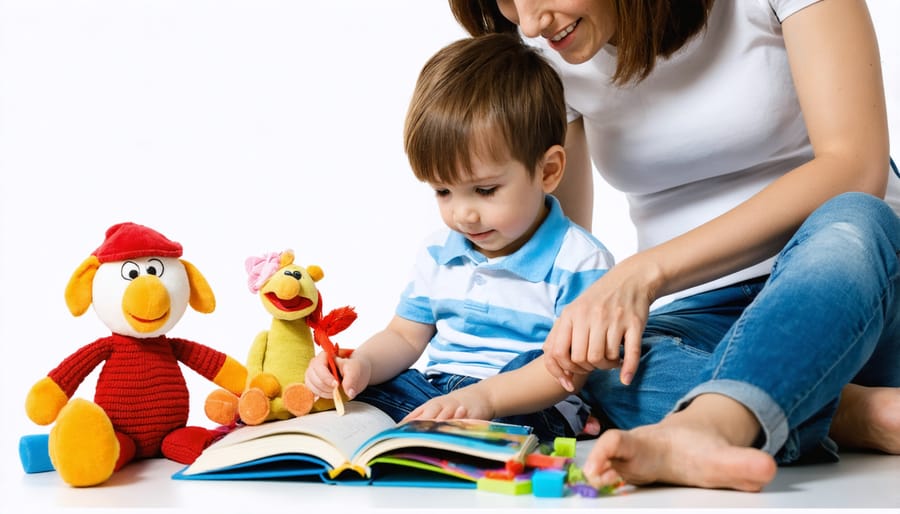Imagine your child sitting cross-legged on the floor, weaving tales of brave knights and magical kingdoms using nothing but their favorite stuffed animals and boundless imagination. This natural form of creative development through play does more than entertain—it builds essential life skills that shape their emotional and cognitive growth.
Storytelling play serves as a powerful tool for children to process their experiences, express complex emotions, and develop crucial social skills. When children create and act out stories, they’re actually rehearsing real-life scenarios in a safe, controlled environment. They learn to navigate challenging situations, develop empathy by playing different characters, and build confidence in their ability to solve problems.
Recent research shows that children who regularly engage in storytelling play demonstrate stronger language skills, enhanced emotional regulation, and more sophisticated social understanding than their peers. This natural form of expression allows them to make sense of their world while developing the narrative thinking skills they’ll need throughout their lives.
As parents and educators, we have the unique opportunity to nurture this innate ability and watch as our children transform simple moments of play into powerful learning experiences.
The Magic Behind Storytelling Play

What Makes Storytelling Play Different
Unlike traditional storytelling where children passively listen, or regular play where activities might lack narrative structure, storytelling play combines the best of both worlds to create unique creative learning experiences. In this special form of play, children become active participants in shaping the narrative, using their imagination to influence the story’s direction while physically acting out different roles and scenarios.
What truly sets storytelling play apart is its fluid nature. Children can seamlessly switch between being the storyteller and the character, allowing them to explore different perspectives and emotions in a safe, playful environment. They’re not just following a predetermined plot – they’re creating, problem-solving, and expressing themselves all at once.
The interactive element also makes storytelling play particularly engaging. Props become magical objects, everyday spaces transform into fantastic worlds, and children learn to collaborate with others to weave complex narratives. This combination of physical movement, emotional expression, and creative thinking creates a rich, multisensory experience that regular storytelling or standard play activities alone cannot match.
The Brain-Building Benefits
When children engage in storytelling play, their brains light up with activity across multiple regions. Research shows that creating and acting out stories strengthens neural pathways essential for language development, memory formation, and creative thinking. As children weave tales and take on different characters, they exercise their prefrontal cortex – the brain’s command center for planning, problem-solving, and emotional regulation.
Dr. Sarah Thompson, a child development specialist, explains: “During storytelling play, children aren’t just having fun; they’re building crucial cognitive skills. Their brains are making connections between ideas, developing empathy through character perspective-taking, and strengthening executive function skills.”
This type of play also enhances working memory as children keep track of plot points and character details. The process of creating narratives helps develop sequencing skills and cause-and-effect understanding, which are fundamental to academic success. Additionally, when children engage in collaborative storytelling with peers or adults, they strengthen their social cognition and communication abilities.
The imaginative nature of storytelling play also promotes neuroplasticity – the brain’s ability to form new connections and adapt to new learning experiences.
Building Emotional Intelligence Through Stories
Understanding Feelings Through Characters
Through storytelling play, children discover a safe and engaging way to explore complex emotions. When a child acts out stories or creates their own narratives, they naturally begin to identify with different characters’ feelings and experiences. This connection between artistic expression and emotional development helps children build crucial empathy skills.
For example, when a child pretends to be a character who feels scared of the dark, they’re actually processing their own fears in a manageable way. By giving voice to these characters, children learn to articulate emotions they might otherwise struggle to express. They might say, “The little bear is worried about his first day of school,” when actually working through their own anxiety about similar situations.
Parents and educators often notice that children become more comfortable discussing feelings after engaging in character play. Whether using puppets, stuffed animals, or their imagination, kids naturally incorporate emotional scenarios into their stories. This process helps them develop emotional vocabulary and understanding.
The beauty of storytelling play lies in its gentle approach to emotional learning. Rather than directly confronting difficult feelings, children can explore them through the safe distance of character play, gradually building confidence in managing their own emotional experiences.

Problem-Solving Through Plot
Through storytelling play, children naturally develop essential problem-solving skills as they navigate fictional scenarios and challenges. When a child pretends their toy dinosaur can’t cross a river, they’re actually practicing creative thinking by coming up with solutions like building a bridge or finding an alternative path.
These imaginative scenarios give children a safe space to work through real-life challenges they might face. For example, a child who’s nervous about their first day of school might act out similar situations with their stuffed animals, testing different approaches and outcomes without real-world consequences.
Parents and caregivers can enhance this learning by asking open-ended questions during play: “What do you think the character should do next?” or “How else could they solve this problem?” This gentle guidance helps children explore multiple solutions and develop flexible thinking patterns.
Dr. Sarah Chen, a child development specialist, notes that “When children work through challenges in their stories, they’re building a mental toolkit they can apply to real-world situations. They learn that problems have multiple solutions and that it’s okay to try different approaches.”
Stories also help children understand cause-and-effect relationships. As they create narratives where one action leads to another, they develop logical thinking skills and learn to anticipate consequences. This natural progression from imagination to practical problem-solving makes storytelling play an invaluable tool for cognitive development.
Simple Ways to Encourage Storytelling Play
Starting Small: Easy Story Starters
Starting storytelling play doesn’t have to be complicated. In fact, the simpler you begin, the more comfortable both you and your child will feel. One of the easiest ways to start is by using everyday objects as story props. A wooden spoon can become a magic wand, or a cardboard box might transform into a spaceship.
Begin with familiar scenarios from your child’s daily life. For example, “Let’s tell a story about going to the park” or “What happened when we visited grandma?” These situations provide a comfortable foundation that children can easily relate to and expand upon.
Another effective approach is the “What if?” game. Ask simple questions like “What if your teddy bear could talk?” or “What if we could fly to the moon for breakfast?” These prompts spark imagination while keeping the story structure manageable.
Picture books can also serve as excellent springboards. After reading a story together, ask your child, “What do you think happens next?” or “What if the story ended differently?” This helps children understand story structure while encouraging their creativity.
Remember to follow your child’s lead. If they’re excited about pirates one day and dinosaurs the next, let the stories flow in that direction. The goal is to make storytelling play a natural, enjoyable experience that grows organically with your child’s interests and abilities.
Creating Story-Rich Environments
Creating environments that spark storytelling doesn’t require elaborate setups or expensive materials. Start by designating a cozy corner in your home or classroom where children feel safe and comfortable to let their imaginations soar. Soft cushions, blankets, and gentle lighting can help create an inviting atmosphere that encourages children to settle in and share their stories.
Consider setting up various themed areas within your creative play environments that can inspire different types of stories. A simple cardboard box can become a spaceship, a castle, or a submarine. Open-ended props like scarves, blocks, and natural materials (pinecones, shells, or smooth stones) can transform into countless story elements in children’s hands.
Rotate materials regularly to maintain interest and spark fresh narratives. Include multicultural items, pictures, and books that reflect diverse experiences and perspectives. This helps children develop inclusive storytelling and broader cultural understanding.
Remember to provide both quiet spaces for individual storytelling and open areas for collaborative story creation. Simple puppets, dress-up clothes, and a small stage area can encourage performance-based storytelling. Even everyday objects like kitchen utensils or office supplies can become powerful story prompts when presented thoughtfully.
Most importantly, show genuine interest in children’s stories and participate when invited. Your engagement validates their creativity and encourages continued storytelling exploration.

When to Seek Professional Support
While storytelling play is typically a healthy and enriching activity, there are times when it might reveal underlying concerns that warrant professional attention. As parents and caregivers, being attentive to certain patterns can help ensure children receive support when needed.
Watch for recurring themes of violence, intense fear, or distress in your child’s stories. While some dramatic elements are normal, persistent dark themes might indicate emotional struggles or exposure to concerning content. Similarly, if a child repeatedly tells stories about isolation, rejection, or being helpless, this could signal social or emotional challenges.
Pay attention if your child’s storytelling becomes significantly withdrawn or changes drastically. For instance, a usually expressive child who suddenly stops engaging in storytelling, or one who becomes fixated on telling the same disturbing story repeatedly, might benefit from professional guidance.
Notice how your child processes real-life events through their stories. While it’s normal for children to work through experiences this way, if they seem stuck on traumatic events or show intense anxiety while storytelling, consulting a child therapist could be helpful.
Consider seeking professional support if:
– Stories consistently reflect feelings of worthlessness or hopelessness
– Storytelling becomes a way to avoid real-world interaction
– The child shows extreme emotional responses during story play
– Stories regularly include self-harm themes or concerning behaviors
– The child appears trapped in negative narrative patterns
Remember that early intervention can make a significant difference. A child mental health professional can help determine whether concerning elements in storytelling play reflect normal developmental stages or indicate needs for additional support. They can also provide strategies to help your child process emotions and experiences more effectively through storytelling.
Trust your parental instincts. If something about your child’s storytelling play doesn’t feel right, it’s perfectly okay to seek professional guidance for peace of mind.
As we’ve explored throughout this article, storytelling play is a powerful tool that nurtures children’s emotional, social, and cognitive development. Through the simple act of creating and sharing stories, children learn to express their feelings, develop empathy, and make sense of the world around them. Whether it’s using puppets, creating characters with building blocks, or acting out scenarios with stuffed animals, each storytelling experience builds important life skills.
Remember that you don’t need to be a professional storyteller to engage in this valuable form of play with your child. The most important elements are your presence, enthusiasm, and willingness to enter their imaginative world. Start small, perhaps with a favorite toy or a simple “what happens next” game during daily activities.
Pay attention to the stories your child tells – they often reveal their thoughts, worries, and dreams. These precious moments of connection can help you better understand and support your child’s emotional needs while strengthening your bond.
As parents and caregivers, we have the wonderful opportunity to nurture our children’s creativity and emotional intelligence through storytelling play. So set aside some time today to enter the magical world of make-believe with your child. The stories you create together will become treasured memories and valuable building blocks for their future development.


